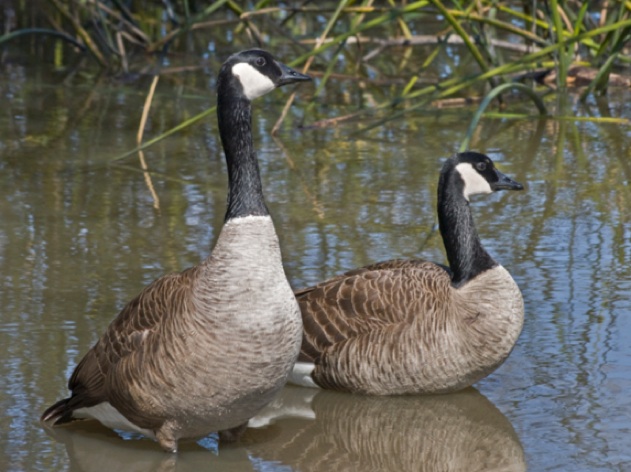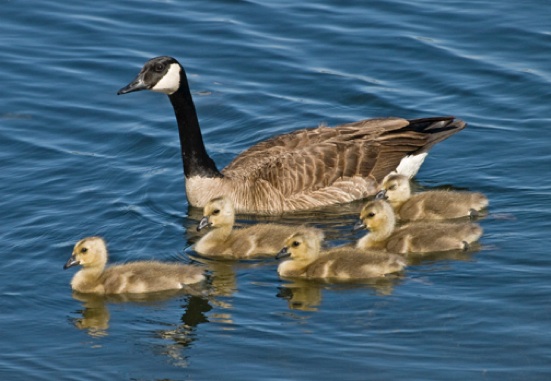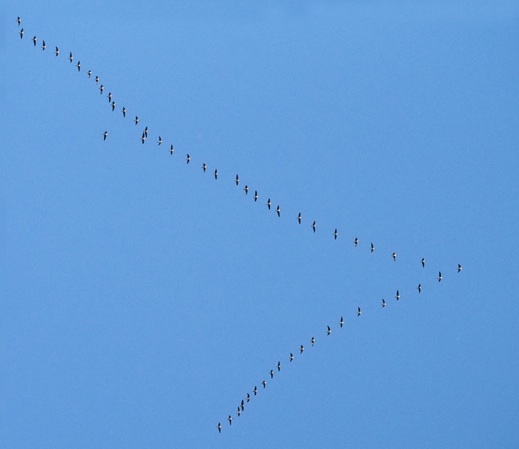A practical guide to bird watching in Sonoma County, California
(Unless otherwise indicated, all phone numbers are in the 707 area code)
A practical guide to bird watching in Sonoma County, California
(Unless otherwise indicated, all phone numbers are in the 707 area code)


In the minds of most people, the quintessential goose. Our most common goose, both on the ground and in the air. No matter how many times I see it, the sight of large numbers of Canada Geese in neat V-formations (often honking loudly, their wing beats audible when flying low) is always thrilling.
Black head and neck with a white "chin strap." Black legs, black tail feathers. Otherwise brown overall, but usually paler at the breast and always white under the tail. Usually in flocks or small groups, typically (but not always) close to water. May be in city parks, large lawns, agricultural fields, or near farm ponds or any other body of fresh water, including water hazards on golf courses. Rarely seen at the coast.

Yes, it's very confusing, and I don't have all the answers, but, from the perspective of the casual or even the more serious birder in Sonoma County, it's probably sufficient to accept that locally you’re most likely to see 1. Canada Goose (ignoring subspecies); 2. Cackling Goose (ignoring subspecies); or 3. the Aleutian subspecies of Cackling Goose (formerly considered the Aleutian subspecies of Canada Goose). I make this assertion based on what I have most commonly observed in the county myself. Others may disagree. The Aleutian subspecies of Cackling Goose is characterized by a distinct (usually half an inch or more wide) white band at the base of the black neck, although any of the Cackling Goose subspecies may show traces of white at the base of the neck--which brings me to the Canada Geese in the top photo on this page: These full-sized birds show a hint of a white band (the bird on the left more prominently). The white band alone is not a reliable way to separate Canada Goose and Cackling Goose.

Hybrids are usually the result of matings between members of local, non-migrating Canada Goose populations and domesticated, non-migrating barnyard geese or the introduced Greylag Goose. Lucchesi Park, in Petaluma, is home to a small group of Greylags, and Canada Goose hybrids show up there. Isolated hybrids may show up anywhere, however, and there may be some hybrid birds in migrating populations. Hybrids typically look vaguely like Canada Goose, but with plumage or other features that are not quite right. Legs are often orange rather than black. The chin strap may disappear or become a vague patch at the throat, the neck may be gray rather than black, the bill may be pink rather than black. Personally, I find these mixes interesting and always wonder about parentage. Most birders, however, treat them with about the same respect that urban pigeons get. Still, they are birds.
May be confused with Greater White-fronted Goose in flight, simply because birds overhead at high altitude are hard to see. If you can see orange legs and feet and a pale bill on a large goose in flight, it may be Greater White-fronted Goose. Greater White-Fronted Goose will also show white at the base of the bill, although that is very hard to see in flight. The white chin strap of Canada Goose often is visible in flight, as is the bird's white rump. When seen flying from directly behind, Canada Goose will show a white band around the rump.

Further reading:
Bolander and Parmeter, Birds of Sonoma County California, rev. ed., 2000, p. 28
Brinkley, National Wildlife Federation Field Guide to Birds of North America, 2007, p. 58
Burridge, ed., Sonoma County Breeding Bird Atlas, 1995, p. 35
Dunn and Alderfer, eds., National Geographic Field Guide to the Birds of North America, 5th ed., 2006, p. 24
Dunn and Alderfer, eds., National Geographic Field Guide to the Birds of North America, 6th ed., 2011, p. 20
Dunne, Pete Dunne’s Essential Field Guide Companion, 2006, pp. 26-27
Ehrlich, Dobkin, and Wheye, The Birder's Handbook, paperback edition, 1988, p. 58
Fix and Bezener, Birds of Northern California, 2000, p. 73
Floyd, Smithsonian Field Guide to the Birds of North America, 2008, p. 34
Kaufman, Field Guide to Birds of North America, 2000, p. 46
Kaufman, Field Guide to Advanced Birding, 2011, pp. 106, 142
Lukas, Bay Area Birds: From Sonoma County to Monterey Bay, 2012, pp. 2-4
Parmeter and Wight, Birds of Sonoma County California, Update (2000-2010), 2012, p. 5
Peterson, Birds of Eastern and Central North America, 5th ed., 2002, p. 62-64
Peterson, Field Guide to Birds of Western North America, 4th ed., 2010, p. 18
Peterson, Western Birds, 3rd ed., 1990, p. 40
Sibley, Field Guide to Birds of Western North America,1st ed., 2003, p. 70
Stokes, Stokes Field Guide to the Birds of North America, 1st ed., 2010, p. 13
Vuilleumier, American Museum of Natural History, Birds of North America: Western Region, 2011, p. 42
Voice: Cornell Lab of Ornithology: All About Birds--Canada Goose
© Colin Talcroft, 2009, 2010, 2011, 2012, 2013
Unless noted, all photos by the author. If you would like to use one of my images, please ask for permission for non-commercial use with proper credit or commercial use with proper compensation.
A Canada goose individual with a clear white band at the base of the black neck (often associated with Cackling Goose), but all other features point to Canada Goose



Canada Goose hybrid or simply an individual with atypical face and neck patterning
Canada Goose hybrid (probably with Greater White-fronted Goose, or Greylag Goose)


Canada Goose with chicks about two weeks old
Place to Play Park, Santa Rosa, May 5, 2011
Canada Geese, Spring Lake, Santa Rosa, February 23, 2011

Yes, they really do fly like that.
Canada Geese over Spring Lake, Santa Rosa, October 17, 2012
1990-2013 Sonoma County data. Graph provided by eBird (www.ebird.org), generated May 30, 2013
Canada Goose
Branta canadensis

EBird reported occurrence in Sonoma County